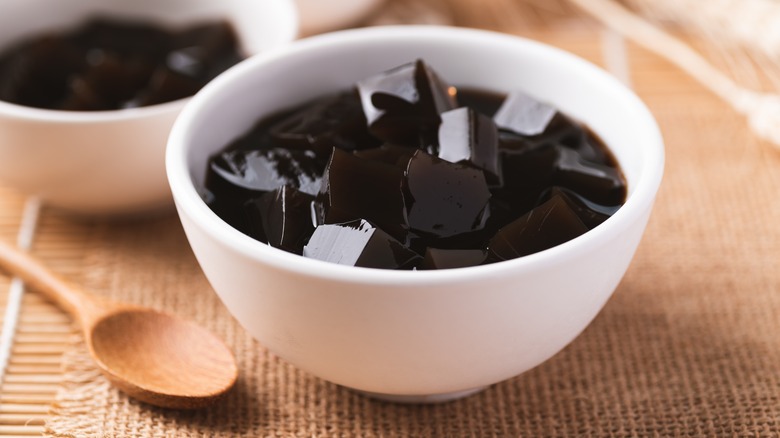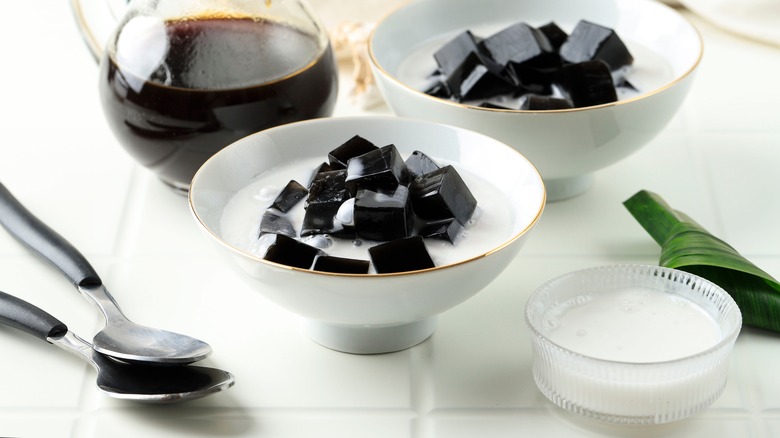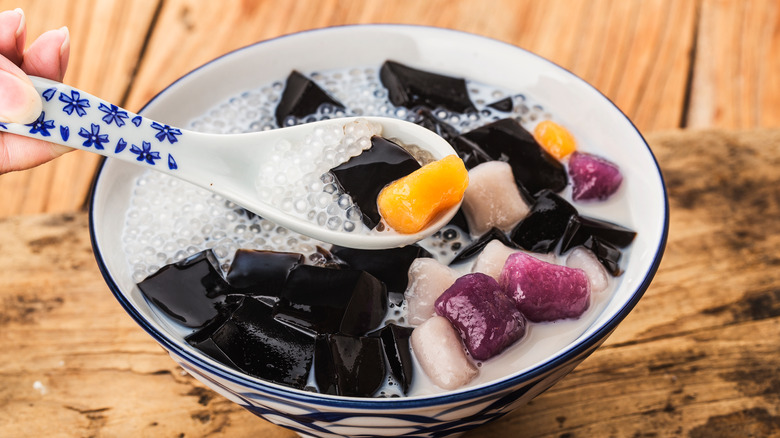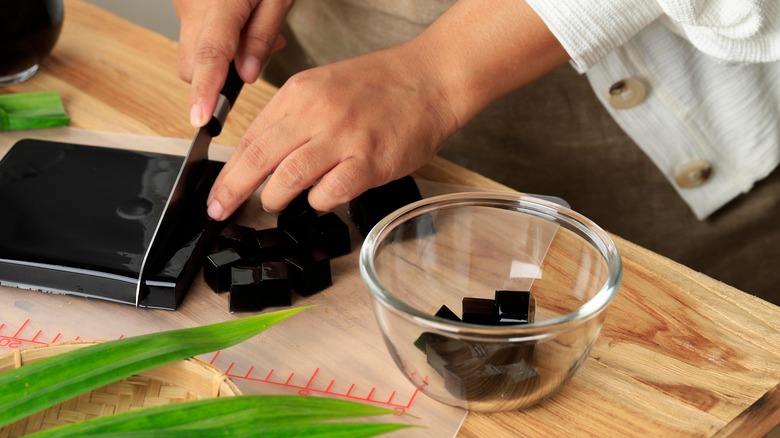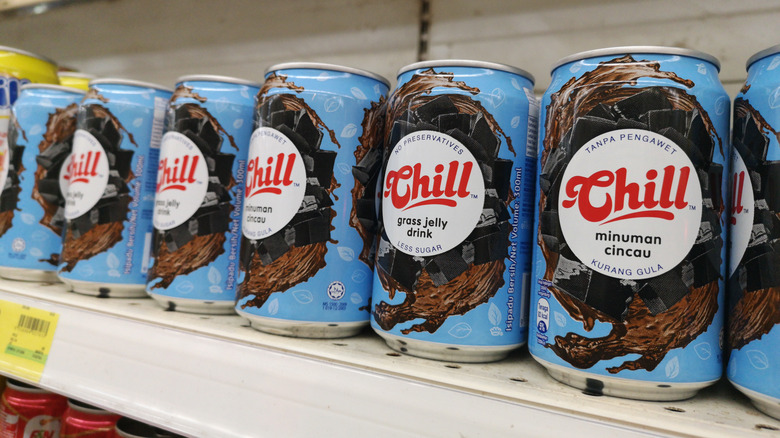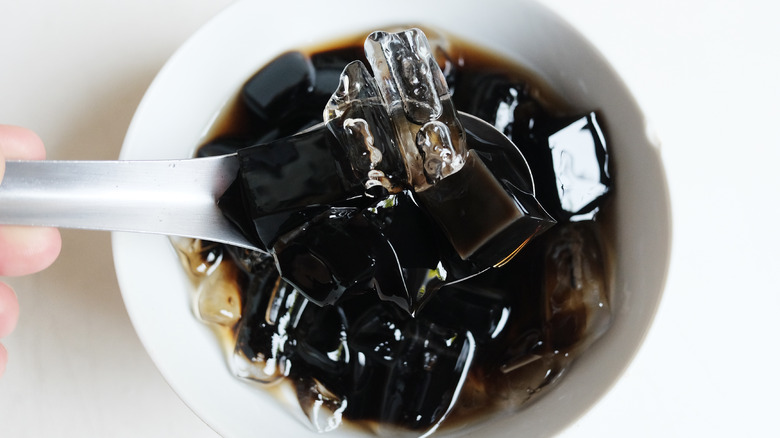Grass Jelly: The Herbal Asian Dessert That Will Refresh Any Time Of Year
Though grass jelly is known as a dessert across Asia, it wasn't originally served as one. Instead, according to Vice, it was used as a heat stroke remedy by the Hakka, an ethnic group in China. After spending all day harvesting a mint-like crop called Platostoma palustre, Hakka farmers would dry it to make grass jelly, which was used to refresh themselves after laboring in the heat of summer.
Nowadays, grass jelly is eaten by everybody, not just farmers, but it's still popular during the summer due to its cooling properties. Taiwan is one of the largest producers of grass jelly in Asia, but per Food Network, it's ubiquitous throughout all of East and Southeast Asia. You can find it at most boba shops as a beverage mix-in, or sometimes as an ice cream topping. It can be served either in the form of chunks or strands, sweetened with simple syrup, evaporated milk, or unflavored soy milk. Whether you enjoy it as a drink or as a parfait, grass jelly is always served chilled.
What is grass jelly?
Grass jelly is nearly identical to gelatins in appearance, but the two couldn't be more different. In fact, grass jelly contains no gelatin at all. As Lion Brand explains, grass jelly instead gets its gelatinous consistency from a combination of starch and Platostoma palustre, also called Chinese mesona. The leaves of the mesona plant are sun dried until they naturally oxidize, and are then boiled for eight hours.
As the leaves cook down, a viscous black tea forms. Per Vice, this tea is first filtered through a cloth before starch is added. Mass-produced grass jelly will usually use potato or corn starch, but traditional jelly uses arrowroot or cassava root. Once the starch is mixed in, the liquid will solidify into a block, and then it's ready to chill and serve. Because grass jelly requires such an extensive cooking process, it's usually sold in a can, but according to Thrillist, fresh grass jelly is usually more elastic and has a lighter color.
What does grass jelly taste like?
If your only experience with grass jelly has been the kind from the can, chances are you didn't find the flavor all that memorable because as Vice shares, it's significantly blander than its fresh counterpart. Grass jelly that hasn't gone through the canning process, however, has a uniquely earthy flavor profile that Thrillist compares to licorice. The herbaceous jelly is naturally bitter, Lion Brand points out, though this is largely overpowered by the sweet ingredients it's normally paired with.
Grass jelly is hardly ever eaten on its own, Lion Brand states, so if it's served "plain," it will have ice and brown sugar syrup at the very least. It's more common to eat grass jelly with fruits, like jackfruit and toddy palm fruit, or mixed into milk-based drinks and desserts. Per Onolicious Hawaii, one of the most popular ways to eat it is on top of crushed ice along with syrup, mochi balls, and azuki beans.
How is grass jelly different from tortoise jelly?
Some people use the terms grass jelly and tortoise jelly interchangeably, but the two are actually entirely different food products, Panda Yoo explains. Though both Chinese desserts have a similar color and gelatin-like texture, tortoise jelly has an altogether different flavor. Plus, it's slightly thicker and made a different way. Also known as guilinggao, according to Taste Atlas, tortoise jelly is made out of powdered turtle shells, making it more like gelatin (derived from the skin and bones of cows and pigs) than grass jelly, which is entirely plant-based. Tortoise jelly is also seasoned with various herbs and spices whereas grass jelly gets its flavor only from starch and mesona leaves.
But despite containing different ingredients, tortoise jelly and grass jelly are served in similar ways. Both can come in canned form, and both are eaten as a dessert. Though tortoise jelly is most known for its medicinal properties (via Carry It Like Harry), when it's consumed as a dessert, it's sweetened with honey to mask its bitterness in the same way grass jelly is.
Where to buy grass jelly
If you don't live in Asia, fresh grass jelly is hard to come by. In countries like Taiwan, Vice shares, street vendors have huge blocks of it that they'll slice off for their customers. Everywhere else, however, it's much easier to find grass jelly by the can. Per Food Network, canned grass jelly is sold by many different brands at most Asian grocery stores, and it's readily available online. Once you open a can of grass jelly, it will last for three to four days when covered in the refrigerator. If you don't plan on eating the whole amount before then, you can also find grass jelly in the form of a shelf-stable powder that you add boiling water to (via Webstaurant Store).
If you don't want to settle for the canned or powdered kind, some specialty bakeries, primarily those located in the Chinatown of major cities, make grass jelly in house. As Thrillist shares, you'll be able to buy it in a tub for about $2.50, and it will be better quality than the kind you get at a grocery store. Food Network adds that boba shops usually have decent grass jelly too, and as one Reddit thread points out, it's usually much softer than the canned variety, and thus easier to drink.
Is grass jelly nutritious?
Grass jelly may be considered a dessert, but that doesn't mean it's an unhealthy treat. The added sugar from the syrup or bubble tea you might enjoy it with is a different story, but according to Livestrong, grass jelly itself is a nutritious food. Because it's derived from the mesona plant, grass jelly is high in both antioxidants and phytonutrients, specifically flavonoids. Research studies published in Procedia Chemistry and Journal of Engineering and Science Research (via Livestrong) found that because of its nutritional composition, consuming grass jelly reduces the risk of intestinal distress, keeps blood sugar at a healthy level, and improves the function of your immune system.
Health Talks adds that the leaves of the plant are also rich in vitamins A, B1, and C. Its vitamin content combined with the fact that it's a reliable source of calcium and fiber makes grass jelly as healthy as it is delicious.
